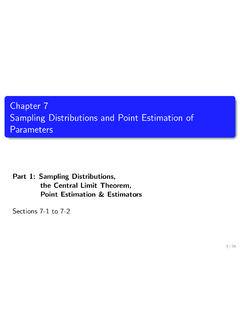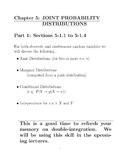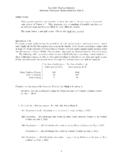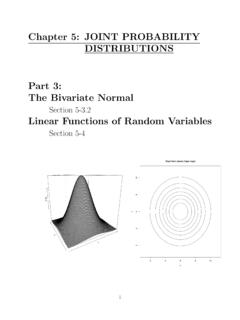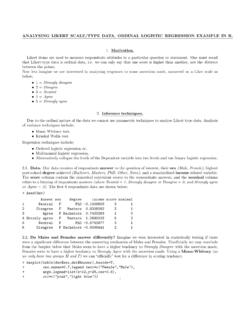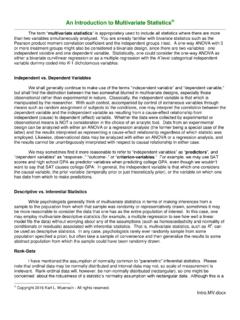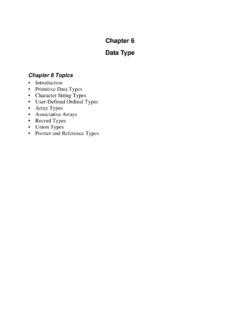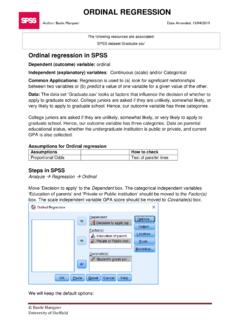Transcription of 2.1 Data: Types of Data and Levels of Measurement
1 data : Types of data and Levels of Measurement 1. Quantitative or Qualitative? ! Quantitative data consist of values representing counts or measurements Histogram of 'Year in School'. 40. " Variable: Year in school 30. Frequency 20. 10. 0. 1 2 3 4. class ! Qualitative (or non-numeric) data consist of values that can be placed into nonnumeric categories. " Variable: Political affiliation (rep, dem, ind). 2. Types of data ! Quantitative " Numerical values representing counts or measures. " Something we can `measure' with a tool or a scale or count.
2 " We can compare these values on a number line. ! 2 pounds is less than 4 pounds " You can take a mathematical average' of these values, can be used in computations. ! weight ! number of students in a class 3. Types of data ! Qualitative (or non-numeric). " Non-numerical in nature (but could be `coded'. as a number, so be careful). ! low=1, med=2, high=3 (still qualitative). " Could be considered a label in some cases. ! Political affiliation (dem, rep, ind). ! Numbers on a baseball uniform " #90isn't larger than #45 in the mathematical sense.
3 They're just a label. ! ID (34B, 67AA, 19G, ). ! Education level (HS, 2-yr, 4-yr, MS, PhD). 4. Types of data ! Qualitative (or non-numeric). " Can't use meaningfully in a computation . ! Can you take the average of the observed political affiliations? No, it's non-numerical. " Dem, Dem, Rep, Ind, Dem, Rep . ! ID #s 56, 213, 788, Average ID? no. " If variable is represented by numbers (as with IDs), ask yourself if an average makes sense . if not, then it's qualitative not quantitative. 5. Types of data ! Quantitative !
4 Qualitative " Number of medals " Medal Type: won by in a Gold/Silver/Bronze given year. Summer Olympic USA medalists 1896-2008. 6. Types of data ! Quantitative ! Qualitative " Number of medals " Medal Type: won by in a Gold/Silver/Bronze single year. " Summarized with a table or chart. 2500. Gold Silver Bronze 2088 1195 1052. 1500. 500. 0. 7. Gold Gold Silver Silver Bronze Bronze Types of data ! Quantitative ! Qualitative " Number of medals " Medal Type: won by in a Gold/Silver/Bronze given year. " Summarized with a " Can be shown with a table or chart.
5 Distribution, or Number of medals in a year summarized with an average, etc. Year Count A distribution. 1896 20 With some The x-axis shows 1900 55 reformatting of the part of the real- 1904 394 number line. earlier data , we can 1908 63 get a count of medals 1912 101 for each year. 0 100 200 300 400 8. 1920 193 count Types of data ! Quantitative " Can be shown with a distribution, or summarized with an average, etc. " Commonly used summaries: ! Average value ! Maximum or Minimum value ! Standard deviation (a measure of spread of the data ).
6 Number of medals in a year " Summarizing a distribution A distribution. with a single value can be The x-axis shows very useful. part of the real- number line. " But be aware that averaging'. (or pooling, or aggregating) can potentially hide some interesting 0 100 200 300 400 9. information (next slide). count Pooling (or Aggregating) data Tracing the rise and fall of each country's total medal count over time . All sports: Only diving: A Visual History of Which Countries Have Dominated the Summer Olympics, 10. New York Times, Aug.
7 22, 2016. Levels of Measurement for Qualitative data ! Qualitative (two Levels of qualitative data ). " Nominal level (by name). ! No natural ranking or ordering of the data exists. ! political affiliation (dem, rep, ind). " ordinal level (by order). ! Provides an order, but can't get a precise mathematical difference between Levels . " heat (low, medium, high). " movie ratings (1-star, 2-star, etc.). # Watching two 2-star** movies isn't the same as watching one 4-star** movie (the math not relevant here). " Could be coded numerically, so again, be careful.
8 11. Levels of Measurement for Qualitative data Political affiliation (dem, rep, ind) Nominal Level of pain (low, med, high) ordinal Answer to survey: (strongly disagree, disagree, agree, strongly agree). ordinal Eye color (blue, green, brown, etc.) Nominal 12. Levels of Measurement (Another way to characterize data ). Qualitative data is either Nominal or ordinal (only 2 options). 13. Two kinds of Quantitative data ! Continuous or Discrete? " Continuous ! Can take on any value in an interval ! Could have any number of decimals " weight, home value, height " , , , , etc.
9 " Discrete ! Can take on only particular values " number of prerequisite courses (0, 1, 2, ). " number of students in a course " shoe sizes (7, 7-1/2, 8, 8-1/2, ). 14. Levels of Measurement (Another way to characterize data ). Quantitative data can be either Discrete or Continuous and either Interval or Ratio 15. Levels of Measurement for Quantitative data ! Interval or Ratio? " Interval level ( differences or subtraction level). ! Intervals of equal length signify equal differences in the characteristic. " The difference in 90 and 100 Fahrenheit is the same as the difference between 80 and 90 Fahrenheit.
10 ! Differences make sense, but ratios do not. " 100 Fahrenheit is not twice as hot as 50 Fahrenheit. ! Occurs when a numerical scale does not have a true zero' start point ( it has an arbitrary zero). " Zerodoes not signify an absence of the characteristic. " Does 0 Fahrenheit represent an absence of heat? ! Designates an equal-interval ordering. " 1 to 2 has the same meaning as 3 to 4. 16. Levels of Measurement for ! Interval or Ratio? Quantitative data " Interval level ( differences or subtraction level). ! May initially look like a qualitative ordinal variable ( low, med, high), but Levels are quantitative in nature and the differences in Levels have consistent meaning.


